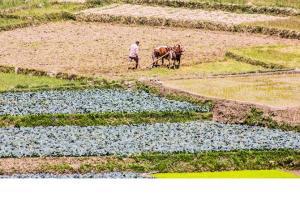In the 'Main Bhi Chowkidar' season, the farmers of Amethi seem to be the new watchmen thanks to growing menace of stray cattle

Representational Image
Amethi: It's 8 p.m. and Kushi Ram, a resident of Baraulia village, is preparing to go to save his farm from the menace of the stray cattle that damage his crops.
ADVERTISEMENT
In the 'Main Bhi Chowkidar' season, the farmers of Amethi seem to be the new watchmen thanks to growing menace of stray cattle.
Showing the hoof marks in his filed, Kushi Ram told this visiting IANS correspondent: "The hoofmarks of the cattle point to the damage to the crop. They ate up all the wheat I had sown. I had to sow all over again."
Surekha Devi, another resident of the Baraulia village, said that she was building a temporary fence of Babool tree branches and twigs around her field.
She said that the thorny plants make the process arduous. "If I don't put up the fence, there will be no wheat to even consume for my five-member family," she said, adding: "I want to protect my crops, so there is little choice. I cannot afford a barbed wire fence."
Venugopal Das, a Dalit from Nara village in the district in the Musafirkhana area of Amethi, blamed the Yogi Adityanath government for the menace.
"They should have made some arrangements against the stray cattle," rued Das, adding that the problem lay in farmers pushing their non-milch cows out of their villages.
The farmers of Amethi, cutting across political lines and castes, claim the menace of stray cattle had worsened after March 2017 when BJP-led Yogi Adityanath assumed office in Uttar Pradesh.
Das pointed out that owing to the fear of vigilante groups, the collapse of local cattle markets and fairs, fall in the value of non-milch cows and bullocks and the campaign against illegal slaughterhouses has led to a situation where both men and women with lathis in their hands are forced to guard their crops during the day and night or stay on the machans built on their fields.
Pointing to his fields, Jagadish Singh asked: "Can you see any crops here? They have been completely destroyed. Now I fear for feeding my family for the rest of the year."
Singh has seven members in his family. He said he produced around 200 quintals of rice and around 120 quintals of wheat from the land. "But as the entire wheat crop has been destroyed I have suffered a huge loss this season," he lamented.
A resident of Dadra village, Bajrangi, confessed he pushed out a male calf earlier this year as he did not have enough feedstock. "I could not feed it, so what to do? I had no option put to push him into another village," he said.
Farmers at the local market said there has been a drastic fall in the sale of non-milch cows and bullocks as there are no takers.
Ali Rehman of Korwa village in Amethi said that it was good that cow slaughter came to a halt but an alternate system should have been put in place to prevent vigiliantism.
"We have seen the news and read in the newspapers how people were lynched on suspicion of transporting the cattles to slaughter houses," Ali said.
He complained that the state government's plan to build shelters for stray cattle is a non-starter.
While travelling through Amethi, several such shelter houses were found incomplete with just a shed and without any fences. One also found several shelters being run by farmers through crowd funding.
On Friday, during Congress General Secretary Priyanka Gandhi Vadra's trip to Faizabad and Rae Bareli, several farmers complained about the menace of the stray cattle, adding they had now become the chowkidars of their fields through the day and night.
In turn, Priyanka urged Prime Minister Narendra Modi to pay heed to the grievances of the farmers.
Catch up on all the latest Crime, National, International and Hatke news here. Also, download the new mid-day Android and iOS apps to get the latest updates
 Subscribe today by clicking the link and stay updated with the latest news!" Click here!
Subscribe today by clicking the link and stay updated with the latest news!" Click here!






